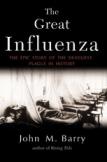Mass Killer
The influenza pandemic that erupted in 1918 was unlike any other disaster in history. Estimates set the number as high as 100 million deaths around the world, as influenza killed more people in a single year than the Black Death did over a century in the Middle Ages. Granted, the plague of the 1300’s wiped out a larger proportion of the population (more than a quarter of Europe), but in a strict body count the influenza pandemic wins hands down.
Assessing its impact in the prologue, John Barry explains: It was the first great collision between a natural force and modern science that included individuals who refused either to submit to that force or to simply call upon divine intervention to save themselves from it, individuals who instead were determined to confront this force directly, with a developing technology and with their minds.
Barry is the distinguished visiting scholar at the Center for Bioenvironmental Research at Tulane and Xavier Universities whose previous books include Rising Tide: The Great Mississippi Flood and How It Changed America. The present work, an all-encompassing history of the epidemic, charts its spread from the American Midwest to the shores of Europe. It also reveals the epic struggle of a handful of men and women who waged a valiant effort to control, if not curb the disease.
In every armed conflict in which the United States has engaged, disease has killed more soldiers than combat. Throughout history, wars have been responsible for spreading all sorts of maladies, so it was no surprise that something as deadly as the outbreak of influenza would occur during the Great War. Ironically, members of the American medical research community expected such a situation and thought they were prepared for it. They anticipated the outbreak correctly but were sadly mistaken about their readiness to deal with it.
Barry sets the stage for the epidemic’s outbreak by reviewing the cast of characters who would eventually be marshaled to fight it. These early warriors included William Henry Welch, Simon Flexner, William Park and Rufus Cole. Later Oswald Avery, Anna Wessel Williams, Paul A. Lewis and Richard Shope would be enlisted in the struggle to identify the cause of the disease, find a cure and develop an effective vaccine.
According to Barry, epidemiological evidence points to a new influenza strain that originated in Haskell County, Kan., in early 1918. The virus traveled east across the state to a large army base, and from there to Europe, the author explains. Later it began its sweep through North America, through Europe, through South America, through Asia and Africa, through isolated islands in the Pacific, through all the wide world.
The speed with which this happened was due to a combination of bad luck, the refusal of some military and public officials to heed the medical community’s dire warnings and the simple fact that there was a war going on and men were on the move across the globe.
Barry’s account of how the influenza spread through military camps virtually unchecked and then spread into the civilian population reads like a novel. The key players, dates and important decisions that determined the direction the epidemic would take and the measures to combat it are all meticulously listed. But it is the anecdotes and personal stories of those touched by the influenza that flesh out the story and turn this lengthy study into an unexpected page turner. Without sacrificing the scholarship that went into researching the topic, the author is able to heighten its dramatic impact by the way he develops his time line, uses facts and melds personal accounts of the events into the flow of the text.
Clifford Adams of Philadelphia, for example, remembered his city shut down by the epidemic and in his neighborhood, People were dying like fliesbodies stacked upstacked up out to be buried.They couldn’t bury them.
It is the chaotic picture of a major city in complete disarray. The city morgue had room for thirty-six bodies. Two hundred were stacked there. No more bodies would fit. Bodies lay in homes where they died, as they died, with bloody liquid seeping from nostrils or mouths. Corpses were wrapped in sheets, pushed in corners, left there sometimes for days.
This graphic depiction and others like it illustrate the horror of life for those who lived during this time. In a single day (Oct. 10, 1918), 759 people died in Philadelphia alone (almost 4,600 in a week), and this scene was replayed in big cities and small hamlets not only all over the United States, but over the world. In just 16 days, 14 percent of the population of the Fiji Islands died of influenza, and 10 percent of the population of the state of Chiapas in Mexico succumbed, as did 22 percent of the islanders of Western Samoa.
An extraordinary event that is often overlooked today, the story of the influenza pandemic of 1918 is one that should not be forgotten. As Barry reminds us in the book’s afterword, Every expert on influenza agrees that the ability of the influenza virus to reassort genes means that another pandemic not only can happen. It almost certainly will happen.
This is not an attempt to scare the reader so much as to remind him that in an ever-changing world, unknown diseases will always be a potential threat.
This article also appeared in print, under the headline “Mass Killer,” in the October 25, 2004, issue.








